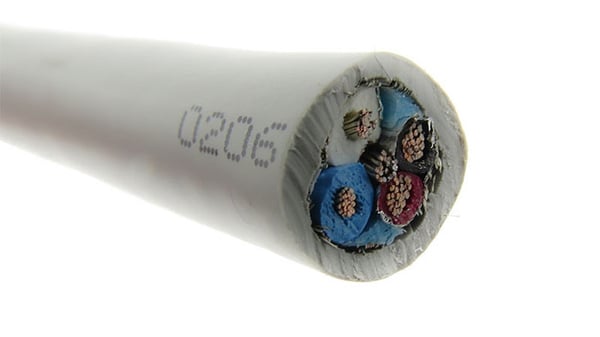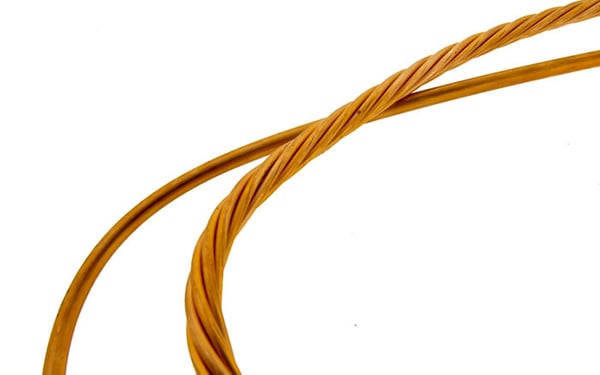Cable assembly conductors may seem like a complicated topic, but many of the properties that govern these cables are quite straightforward. Making sense of the differences between stranded conductors and solid conductors, and even the various conductor plating specifications that are at play, is easy. You just need to keep a few key things in mind. Even a general understanding of the wire flexibility requirements, current draw, and the operating environment will help guide you toward the best bulk cable design options that exist.

Cable cut open showing internal conductors
An Overview of Stranded Conductor Wires in Electrical Cable Assemblies
Stranded conductor wires, as the name suggests, are those that are made up of a small number of wires that have either been bundled or wrapped together to form a larger conductor that is then used for a range of different applications. One of the major benefits of this comes by way of durability. Stranded wire simply offers a higher level of resilience to factors like metal fatigue due to bending. Just like taking a paper clip and bending it 20 times to failure, solid conductor wires can fail due to a similar cyclic bending event. Stranded conductors allow for a tighter bend radius and will not be subjected to the same levels of mechanical stress when compared to their solid conductor counterparts.
The number of strands in a stranded conductor wire will also depend on many different factors. Generally speaking, all individual conductors are the same wire AWG, and the lowest number is usually seven. In this configuration, there is one strand in the middle of the conductor and the remaining six surround it in close contact. Then, we have 19 strands (with the aforementioned layer of seven) with an additional layer of 12 strands on top of it. Stranded wire conductors with 37, 49, 70, and even 100 strands are also available, though again all of this will depend on exactly what you need the conductor for in the first place. The more strands that are present, the more flexible and durable that cable becomes. The bulk cable’s flexibility is directly related to the number of strands; the wire jacket material also contributes to flexibility. If you need an ultra-flexible cable, try pairing a silicone rubber jacket with a high strand count wire. Some ultra-flexible cables have more than 1,600 individual strands that are each 0.08mm in a bulk cable diameter that is less than ¼ inch.
Stranded conductor wires are manufactured in a process that is very similar to their solid counterparts, although there are several key differences. After copper is obtained from an ore, an extrusion machine is then used to create wire by forcing the metal through a series of dies to arrive at the intended diameter. For stranded cables, those multiple smaller strands are then twisted together to form a single conductor (again, using the number guides outlined above) before the jacket is finalized. The cord is cut via a cutting machine, and an extruded jacket is applied to insulate the cable.
Solid Conductor Wires: Breaking Things Down
Solid conductor wires are used in cable assemblies for a variety of applications but are less frequently used due to their rigidity. As the name implies, these consist of one piece of metal wire that is then insulated. Solid conductors are ideal for situations where:
- Low cost is required (they're typically less to produce than their stranded alternatives).
- There is little need for flexibility for tight bend radiuses
- Solid conductors can carry higher current for the same wire diameter when compared to stranded alternatives.
- Solid conductors’ rigidity can be formed and bent to retain their shape. Solid conductors are, however, impractical in large diameters. They are too rigid and cannot be bent.
The sizes of solid conductor wires can also vary wildly depending on the exact application in question. It can range from a 4/0 AWG (0000 AWG), which is a diameter of 0.4600 inches, all the way up to a 38 AWG with a diameter of 0.0040 inches.
The major difference between the construction method of the solid conductor wires versus their stranded counterparts ultimately comes down to how the cable is covered. Remember that solid cables are typically fabricated with just that single, solid strand of copper (one per conductor). Metal is still extracted from an ore, an extrusion machine is still used to create the copper wire, and eventually it is still cut and jacketed. Solid conductor wires just use a single larger diameter conductor instead of several smaller diameter conductors bundled together.
When to Use Stranded Copper Wire vs. Solid Conductor Wire
Both solid and stranded conductor types bring their fair share of advantages and disadvantages to the table. Solid conductor wires are perfect for applications where cost is a concern or where they remain static with no movement or routing (this is due to their inherent rigidity). Because of this, solid conductor cables are often chosen in structured wire setups like in electrical wiring in buildings or as network cable running through the walls. For example, Romex brand wire used in homes is usually three sets of 14 AWG solid conductor wire. To anyone who has used this it should be clear how stiff this bulk wire is and the difficulty routing in tight quarters.
Stranded cables, on the other hand, are more flexible. They're very common in pre-made Ethernet cables, for example. Stranded cables are the default wire chosen for most electronics and cable harnesses due to their versatility and flexibility.

Example of stranded and solid copper wire conductor wire.
The Pros, Cons and Major Limitations of the Four Common Conductor Plating and Coating Options
Once the conductor cross section type is chosen, the conductor coating or plating must be reviewed. There are four main types of conductor plating and coating options for you to choose from depending on your needs. These are:
-
No coating: Copper has many beneficial characteristics on its own, which is why wires with no coating are sometimes used. However, without a protective coating, copper will oxidize and corrode when exposed to even small amounts of moisture. This corrosion will lead to open circuits or increased circuit resistance. Both can wreak havoc on your design solution since uncoated copper wire lacks humidity and high temperature resistance that other variations might have.
- Tin-plated wire: The major benefit here is that tin-plated wire offers both a resilience to corrosion from humidity and moisture and exhibits excellent crimp contact resistance and solderability. However, both properties can deteriorate over time if left unchecked.
- Silver-plated wire: Silver-plated wire is known for both its excellent crimp contact resistance and solderability, both of which should remain stable over the lifetime of the wire. Silver plated wire offers tremendous corrosion protection and is common in mil-aero applications that demand resilience to mil-spec type environmental conditions. However, silver coatings have a severely limited maximum service temperature when compared to alternatives like nickel.
- Nickel-plated wire: This type of wire has the best maximum service temperature there is, coming in at 460° However, its electrical conductivity is only about 25% that of copper. Likewise, solderability requires active flux in order to be successful.
Industry Specifications That Relate to the Conductor Plating
Likewise, there are three main industry specifications that relate to conductor plating that you will need to concern yourself with. These are:
- ASTM B-33 Specification for Tinned Soft or Annealed Copper Wire for Electrical Purposes: This standard outlines wire sizes, tensile strength, elongation requirements, and more, all concerning tinned, round, soft or annealed copper wire to be used for electrical purposes. One of the requirements involves tin coating that needs to be firmly adherent to the surface of the copper.
- ASTM B-355 Specification for Nickel-Coated Soft or Annealed Copper Wire: This standard covers nickel-coated, soft, or round copper wire for use in electrical equipment. Five classes are covered (2, 4, 7, 10 and 27) and properties like elongation, resistivity, and even the dimensions of the wire are all determined.
- ASTM B-298 Specification for Silver-Coated Soft or Annealed Copper Wire: This covers silver coated, soft, round copper, and other types of wires that are intended to be used for the purposes of electrical equipment. They are separated into classes A, B, C, D, and E based on their tensile strength, the weight of the coating, dimensional measurements, and more.
Wire Specs That Relate to Conductor Plating
In terms of wire specifications that relate to conductor plating, the main ones you'll want to familiarize yourself with include:
- UL 1007 (tinned): This covers the specifications for wires referred to as "hook-up wires," which themselves are commonly used for the internal wiring of electronics and electrical equipment and usually have a voltage rating of between 300 V and 600 V. This specification remains one of the most frequently used for low-voltage cable harnesses.
- UL 1659 (nickel plating): Wires that fall under this specification are fabricated with nickel plated conductor material. These conductors exhibited have heavy walls, extruded, PTFE insulation designed to not only bring about a higher level of durability, but a higher voltage rating. The nickel plating provides corrosion protection and allows for their use in some corrosive environments.
- M22759 Wire Specification (silver coating): This specification relates to conductor plating as it is used in the military, aerospace, and defense industries. For anything to meet this spec, it needs to have small dimensions, incredibly high temperature resistance, low weight, and especially low flame propagation. This material may present some sourcing challenges as it has limited global availability.
Summary
Clearly there are a near infinite number of permutations of cable options given the two primary conductor types (stranded vs. solid), dozens of AWG sizes, and countless plating and UL specs. Understanding what the conductor types are and how their unique design attributes impact performance is vital in selecting the proper cable for your application. Similarly, selecting the wrong cable specification can add cost, time, and risk to your project. Partnering with a full-service engineering and manufacturing partner like Epec can help you navigate the hundreds of thousands of different wire options that exist and find the best options for your project. Epec offers thousands of different bulk wire types to address nearly all your program objectives. If there is no existing wire that will meet your needs, we can tool up and extrude our own custom wire configuration that hopefully addresses those needs.
Key Takeaways
- Stranded vs. solid conductors: Stranded wires offer greater flexibility and durability against bending fatigue, while solid wires are less costly, more rigid, and suitable for static applications.
- Strand count impacts flexibility: Higher strand counts improve bend radius and durability, with ultra-flexible cables reaching thousands of tiny strands paired with flexible jackets like silicone.
- Conductor plating choices matter: Tin, silver, and nickel plating each offer different benefits for corrosion resistance, temperature tolerance, and solderability, while bare copper is vulnerable to oxidation.
- Industry standards ensure quality: Specifications like ASTM B-33 (tin), ASTM B-355 (nickel), and ASTM B-298 (silver) define plating adhesion, tensile strength, and resistivity requirements.
- Wire specs vary by application: UL 1007, UL 1659, and M22759 cover specific use cases ranging from low-voltage hook-up wires to aerospace-grade high-temperature conductors.
















